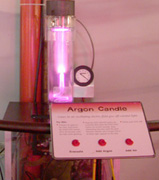|
In this exhibit,
a power source pumps an alternating electric current into an electric
rod. The current changes direction 13 million times per second.
That means the rod goes from being positively charged to being negatively
charged 13 million times per second, creating a powerful alternating
field. The gas in the chamber is made up of charged particles called
protons
and
electrons.
Most of the protons and electrons
are bound together by electrical attraction, but there are some
free electrons in the gas. The free electrons are alternately attracted
and repelled by the charged rod. They speed through the gas, colliding
with other electrons and knocking them free of protons. When the
free electrons fall back into orbit around the protons, they release
energy that you see as glowing light. A pressure gage indicates
the amount of gas inside the tube. The lower the pressure reading,
the less gas in the chamber. When the chamber is filled with gas,
the atoms are closely packed, and the electrons cannot travel far
before colliding with each other. But when the tube is emptied,
the electrons can get enough speed to bump each other free, and
give off energy. Every gas gives off its own characteristic color
when it releases energy. Air glows orange and purple. But when the
chamber is filled with more argon than air, the glow turns whitish.
As more argon enters the tube, a feathery white streamer rises from
the top of the rod. The streamer, which is hot gas rising from the
rod, disappears when the gas pressure in the chamber is too low.
At low pressure, the hot gas spreads out too quickly to form a streamer.
You can notice that the glow seems to follow your hand when the
side of the tube is touched. The alternating electric fields are
stronger between your hand and the rod than elsewhere in the tube.
The electrons release more energy in the stronger electric fields,
and therefore, glow more.
|

|













